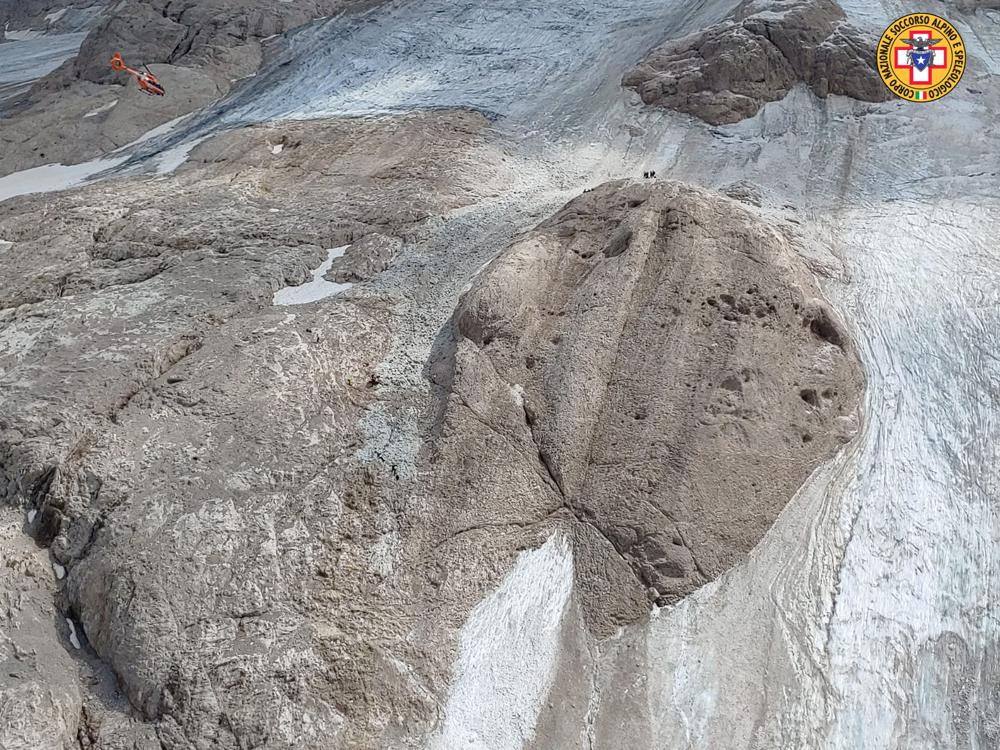Alpine glacier chunk detaches, killing at least 6 hikers

Posted July 3, 2022 9:56 am.
Last Updated July 3, 2022 4:56 pm.
A large chunk of an Alpine glacier broke loose Sunday and roared down a mountain in Italy, sending ice, snow and rock slamming into hikers on a popular trail on the peak and killing at least six and injuring nine, authorities said, warning that the toll might climb.
A local Civil Protection official, Gianpaolo Bottacin, was quoted by the Italian news agency ANSA as providing the toll, but stressing that the situation was “evolving” and that there could be perhaps 15 people missing.
In late evening, the National Alpine and Cave Rescue Corps tweeted a phone number to call for family or friends in case of “failure to return from possible excursions” to the glacier.
Rescuers were checking license plates in the parking lot as part of checks to determine how many people might be unaccounted for, a process that could take hours, Corps spokesman Walter Milan told The Associated Press by telephone.
The glacier, in the Marmolada range, is the largest in the Dolomite mountains in northeastern Italy and people ski there in the winter. But the glacier has been rapidly melting away in recent years.
Experts at Italy’s state-run CNR research center, which has a polar sciences institute, says the glacier won’t exist anymore in the next 25-30 years and much of its volume is already gone.
The Mediterranean basin, shared by southern Europe, the Middle East and northern Africa, has been identified by U.N. experts as a “climate change hot spot,” likely to suffer heat waves and water shortages, among other consequences.
“We saw dead (people) and enormous chunks of ice, rock,” exhausted-looking rescuer Luigi Felicetti told Italian state TV.
Nationalities or ages of the dead weren’t immediately available, Milan said.
Of the hospitalized survivors, two were in grave condition, authorities said.
The fast-moving avalanche “came down with a roar the could be heard at great distance,” local online media site ildolomiti.it said.

This image released on Sunday, July 3, 2022, by the Italian National Alpine and Cave Rescue Corps shows the glacier in Italy’s Alps near Trento a large chunk of which has broken loose, killing at least six hikers and injuring eight others. Alpine rescue service officials, which provided that toll Sunday evening, said it could take hours to determine if any hikers might be missing. The National Alpine and Cave Rescue Corps tweeted that the search of the involved area of Marmolada peak involved at least five helicopters and rescue dogs. (Corpo Nazionale Soccorso Alpino e Speleologico via AP)
Temporarily, the search by helicopter and dogs for any more victims or missing was halted for the night while rescuers evaluated the risk that more of the glacier could break off, Walter Cainelli, after conducting a rescue mission with a search dog, told state television.
Rescuers said blocks of ice were continuing to tumble down. In early evening, a light rain began to fall.
The SUEM dispatch service, which is based in the nearby Veneto region, said 18 people who were above the area where the ice struck would be evacuated by the Alpine rescue corps.
Some of those making the trek in the area where the avalanche barreled through were tied together by rope, according to local emergency services.
But Milan said some of the hikers might be able to get down by themselves, including by using the peak’s cable car.
SUEM said the avalanche consisted of a “pouring down of snow, ice and rock.” The detached section is know as a serac, or pinnacle of ice.
Dubbed the “queen of the Dolomites,” Marmolada rises about 3,300 meters (about 11,000 feet) and is the highest of the 18 peaks in that eastern range of the Italian Alps, offering spectacular views of other Alpine peaks.
The Alpine rescue service said in a tweet that the segment broke off near Punta Rocca (Rock Point), “along the itinerary normally used to reach the peak.”
Heat wave to blame?
It wasn’t immediately clear what caused the section of ice to break away and rush down the peak’s slope. But the intense heat wave gripping Italy since late June loomed as a possible factor.
“The temperatures of these days clearly had influence” on the glacier’s partial collapse, Maurizio Fugatti, the president of Trento Province, which borders Marmolada, told Sky TG24 news.
But Milan stressed that high heat, which soared unusually above 10 C (50 F) on Marmolada’s peak in recent days, was only one possible factor in Sunday’s tragedy.
“There are so many factors that could be involved,” Milan said. Avalanches in general aren’t predictable, he said, and heat’s influence on a glacier “is even more impossible to predict.”
In separate comments to Italian state television, Milan called the recent temperatures “extreme heat” for the peak. “Clearly it’s something abnormal.”
The injured were flown to several hospitals in the regions of Trentino-Alto Adige and Veneto, according to rescue services.
As in other cases of disasters amid nature in Italy, prosecutors opened an investigation to see if there was any indication of possible wrongdoing linked to the avalanche.








